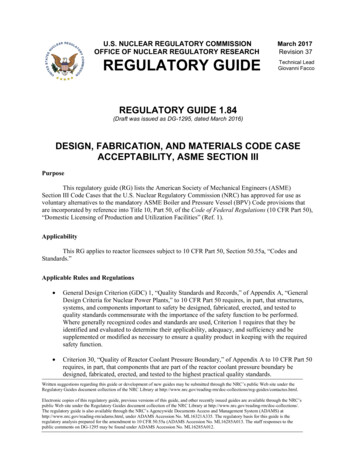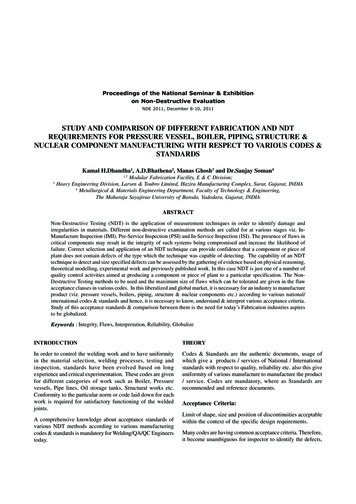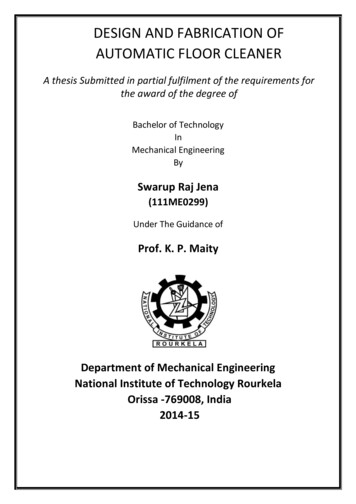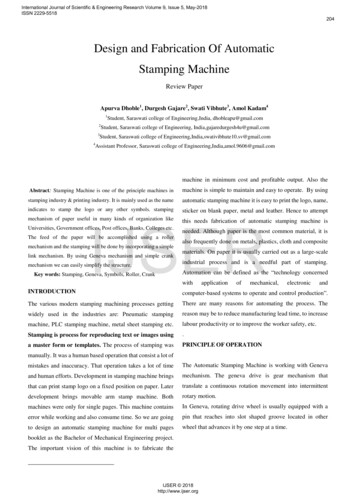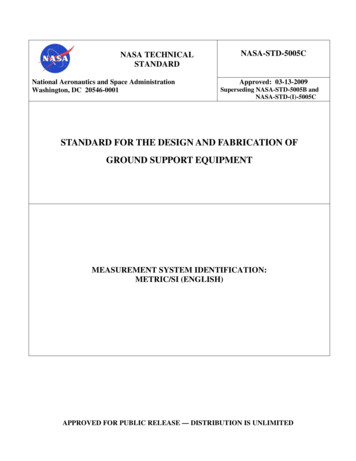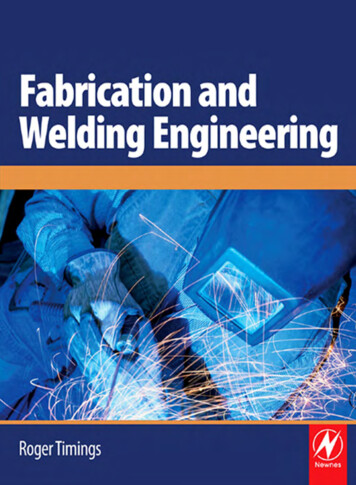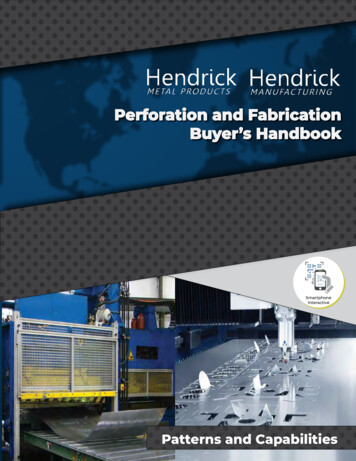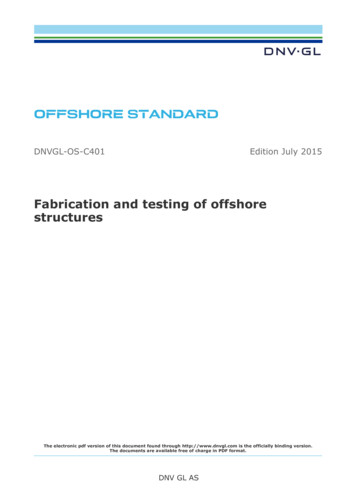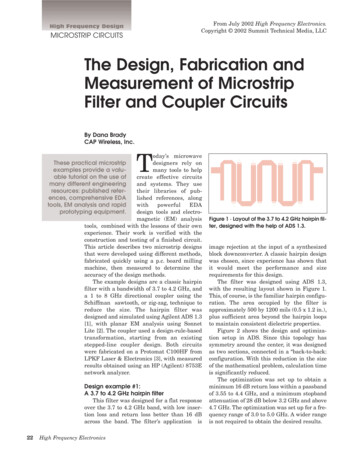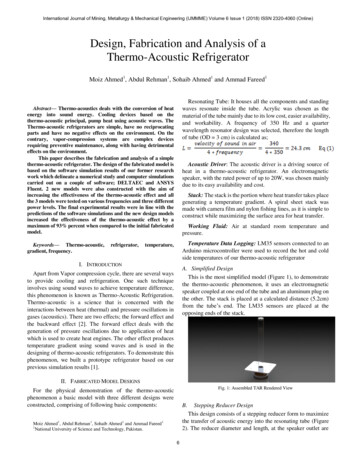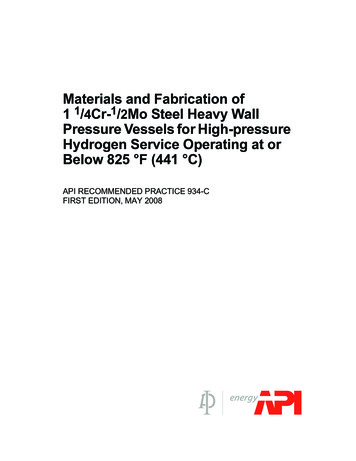
Transcription
Materials and Fabrication of1 1/4Cr-1/2Mo Steel Heavy WallPressure Vessels for High-pressureHydrogen Service Operating at orBelow 825 F (441 C)API RECOMMENDED PRACTICE 934-CFIRST EDITION, MAY 2008
Materials and Fabrication of1 1/4Cr-1/2Mo Steel Heavy WallPressure Vessels for High-pressureHydrogen Service Operating at orBelow 825 F (441 C)Downstream SegmentAPI RECOMMENDED PRACTICE 934-CFIRST EDITION, MAY 2008
Special NotesAPI publications necessarily address problems of a general nature. With respect to particular circumstances, local,state, and federal laws and regulations should be reviewed.Neither API nor any of API's employees, subcontractors, consultants, committees, or other assignees make anywarranty or representation, either express or implied, with respect to the accuracy, completeness, or usefulness ofthe information contained herein, or assume any liability or responsibility for any use, or the results of such use, of anyinformation or process disclosed in this publication. Neither API nor any of API's employees, subcontractors,consultants, or other assignees represent that use of this publication would not infringe upon privately owned rights.API publications may be used by anyone desiring to do so. Every effort has been made by the Institute to assure theaccuracy and reliability of the data contained in them; however, the Institute makes no representation, warranty, orguarantee in connection with this publication and hereby expressly disclaims any liability or responsibility for loss ordamage resulting from its use or for the violation of any authorities having jurisdiction with which this publication mayconflict.API publications are published to facilitate the broad availability of proven, sound engineering and operatingpractices. These publications are not intended to obviate the need for applying sound engineering judgmentregarding when and where these publications should be utilized. The formulation and publication of API publicationsis not intended in any way to inhibit anyone from using any other practices.Any manufacturer marking equipment or materials in conformance with the marking requirements of an API standardis solely responsible for complying with all the applicable requirements of that standard. API does not represent,warrant, or guarantee that such products do in fact conform to the applicable API standard.All rights reserved. No part of this work may be reproduced, stored in a retrieval system, or transmitted by any means, electronic,mechanical, photocopying, recording, or otherwise, without prior written permission from the publisher. Contact the Publisher, APIPublishing Services, 1220 L Street, N.W., Washington, D.C. 20005.Copyright 2008 American Petroleum Institute
ForewordNothing contained in any API publication is to be construed as granting any right, by implication or otherwise, for themanufacture, sale, or use of any method, apparatus, or product covered by letters patent. Neither should anythingcontained in the publication be construed as insuring anyone against liability for infringement of letters patent.This document was produced under API standardization procedures that ensure appropriate notification andparticipation in the developmental process and is designated as an API standard. Questions concerning theinterpretation of the content of this publication or comments and questions concerning the procedures under whichthis publication was developed should be directed in writing to the Director of Standards, American PetroleumInstitute, 1220 L Street, N.W., Washington, D.C. 20005. Requests for permission to reproduce or translate all or anypart of the material published herein should also be addressed to the director.Generally, API standards are reviewed and revised, reaffirmed, or withdrawn at least every five years. A one-timeextension of up to two years may be added to this review cycle. Status of the publication can be ascertained from theAPI Standards Department, telephone (202) 682-8000. A catalog of API publications and materials is publishedannually and updated quarterly by API, 1220 L Street, N.W., Washington, D.C. 20005.Suggested revisions are invited and should be submitted to the Standards Department, API, 1220 L Street, NW,Washington, D.C. 20005, standards@api.org.iii
ContentsPage1Scope . . . . . . . . . . . . . . . . . . . . . . . . . . . . . . . . . . . . . . . . . . . . . . . . . . . . . . . . . . . . . . . . . . . . . . . . . . . . . . . . . . 12References . . . . . . . . . . . . . . . . . . . . . . . . . . . . . . . . . . . . . . . . . . . . . . . . . . . . . . . . . . . . . . . . . . . . . . . . . . . . . . 133.13.2Terms, Definitions, and Acronyms . . . . . . . . . . . . . . . . . . . . . . . . . . . . . . . . . . . . . . . . . . . . . . . . . . . . . . . . . . 2Terms and Definitions . . . . . . . . . . . . . . . . . . . . . . . . . . . . . . . . . . . . . . . . . . . . . . . . . . . . . . . . . . . . . . . . . . . . . 2Acronyms . . . . . . . . . . . . . . . . . . . . . . . . . . . . . . . . . . . . . . . . . . . . . . . . . . . . . . . . . . . . . . . . . . . . . . . . . . . . . . . 34Design . . . . . . . . . . . . . . . . . . . . . . . . . . . . . . . . . . . . . . . . . . . . . . . . . . . . . . . . . . . . . . . . . . . . . . . . . . . . . . . . . . 455.15.25.35.45.5Base Metal Requirements. . . . . . . . . . . . . . . . . . . . . . . . . . . . . . . . . . . . . . . . . . . . . . . . . . . . . . . . . . . . . . . . . . 4Material Specification . . . . . . . . . . . . . . . . . . . . . . . . . . . . . . . . . . . . . . . . . . . . . . . . . . . . . . . . . . . . . . . . . . . . . 4Steel Making Practice . . . . . . . . . . . . . . . . . . . . . . . . . . . . . . . . . . . . . . . . . . . . . . . . . . . . . . . . . . . . . . . . . . . . . 5Chemical Composition Limits . . . . . . . . . . . . . . . . . . . . . . . . . . . . . . . . . . . . . . . . . . . . . . . . . . . . . . . . . . . . . . 5Heat Treatment. . . . . . . . . . . . . . . . . . . . . . . . . . . . . . . . . . . . . . . . . . . . . . . . . . . . . . . . . . . . . . . . . . . . . . . . . . . 5Mechanical Properties . . . . . . . . . . . . . . . . . . . . . . . . . . . . . . . . . . . . . . . . . . . . . . . . . . . . . . . . . . . . . . . . . . . . 566.16.2Welding Consumable Requirements. . . . . . . . . . . . . . . . . . . . . . . . . . . . . . . . . . . . . . . . . . . . . . . . . . . . . . . . . 6Material Requirements . . . . . . . . . . . . . . . . . . . . . . . . . . . . . . . . . . . . . . . . . . . . . . . . . . . . . . . . . . . . . . . . . . . . 6Mechanical Requirements . . . . . . . . . . . . . . . . . . . . . . . . . . . . . . . . . . . . . . . . . . . . . . . . . . . . . . . . . . . . . . . . . 777.17.27.37.47.57.6Welding, Heat Treatment, and Production Testing . . . . . . . . . . . . . . . . . . . . . . . . . . . . . . . . . . . . . . . . . . . . . 7General Welding Requirements . . . . . . . . . . . . . . . . . . . . . . . . . . . . . . . . . . . . . . . . . . . . . . . . . . . . . . . . . . . . . 7Welding Procedure Qualification. . . . . . . . . . . . . . . . . . . . . . . . . . . . . . . . . . . . . . . . . . . . . . . . . . . . . . . . . . . . 7Preheat and Dehydrogenation Heat Treatment (DHT). . . . . . . . . . . . . . . . . . . . . . . . . . . . . . . . . . . . . . . . . . . 8Production Testing of Base Metal Welds . . . . . . . . . . . . . . . . . . . . . . . . . . . . . . . . . . . . . . . . . . . . . . . . . . . . . 9Weld Overlay or Integral Clad . . . . . . . . . . . . . . . . . . . . . . . . . . . . . . . . . . . . . . . . . . . . . . . . . . . . . . . . . . . . . . 9Final Postweld Heat Treatment (PWHT) . . . . . . . . . . . . . . . . . . . . . . . . . . . . . . . . . . . . . . . . . . . . . . . . . . . . . 1188.18.28.38.48.58.6Nondestructive Testing (NDE) . . . . . . . . . . . . . . . . . . . . . . . . . . . . . . . . . . . . . . . . . . . . . . . . . . . . . . . . . . . . . 11General . . . . . . . . . . . . . . . . . . . . . . . . . . . . . . . . . . . . . . . . . . . . . . . . . . . . . . . . . . . . . . . . . . . . . . . . . . . . . . . . 11NDE Prior to Fabrication. . . . . . . . . . . . . . . . . . . . . . . . . . . . . . . . . . . . . . . . . . . . . . . . . . . . . . . . . . . . . . . . . . 11NDE During Fabrication . . . . . . . . . . . . . . . . . . . . . . . . . . . . . . . . . . . . . . . . . . . . . . . . . . . . . . . . . . . . . . . . . . 11NDE After Fabrication and Prior to Final PWHT . . . . . . . . . . . . . . . . . . . . . . . . . . . . . . . . . . . . . . . . . . . . . . 12NDE After Final PWHT. . . . . . . . . . . . . . . . . . . . . . . . . . . . . . . . . . . . . . . . . . . . . . . . . . . . . . . . . . . . . . . . . . . . 12Positive Material Identification. . . . . . . . . . . . . . . . . . . . . . . . . . . . . . . . . . . . . . . . . . . . . . . . . . . . . . . . . . . . . 129Hydrostatic Testing . . . . . . . . . . . . . . . . . . . . . . . . . . . . . . . . . . . . . . . . . . . . . . . . . . . . . . . . . . . . . . . . . . . . . . 121011Preparation for Shipping . . . . . . . . . . . . . . . . . . . . . . . . . . . . . . . . . . . . . . . . . . . . . . . . . . . . . . . . . . . . . . . . . 13Documentation. . . . . . . . . . . . . . . . . . . . . . . . . . . . . . . . . . . . . . . . . . . . . . . . . . . . . . . . . . . . . . . . . . . . . . . . . . 13Figure1Location of Vickers Hardness Indentations . . . . . . . . . . . . . . . . . . . . . . . . . . . . . . . . . . . . . . . . . . . . . . . . . . 8Table1Base Metal Specifications . . . . . . . . . . . . . . . . . . . . . . . . . . . . . . . . . . . . . . . . . . . . . . . . . . . . . . . . . . . . . . . . 4v
IntroductionThis recommended practice applies to newly fabricated heavy wall pressure vessels in petroleum refining,petrochemical and chemical facilities in which hydrogen or hydrogen-containing fluids are processed at elevatedtemperature and pressure. It is based on decades of industry operating experience and the results of experimentationand testing conducted by independent manufacturers, fabricators, and users of heavy wall pressure vessels for thisservice.Licensors and owners of process units in which these heavy wall pressure vessels are to be used may modify and/orsupplement this recommended practice with additional proprietary requirements.
Materials and Fabrication of 1 1/4Cr-1/2Mo Steel Heavy Wall Pressure Vessels forHigh-pressure Hydrogen Service Operating at or Below 825 F (441 C)1 ScopeThis recommended practice presents materials and fabrication requirements for new 1 1/4Cr-1/2Mo steel heavy wallpressure vessels and heat exchangers for high-temperature, high-pressure hydrogen service. It applies to vesselsthat are designed, fabricated, certified, and documented in accordance with ASME BPVC, Section VIII, Division 1 orDivision 2. This document may also be used as a resource for equipment fabricated of 1Cr-1/2Mo Steel.This document may also be used as a resource when planning to modify an existing heavy wall pressure vessel.The interior surfaces of these heavy wall pressure vessels may have an austenitic stainless steel or ferritic stainlesssteel weld overlay or cladding to provide additional corrosion resistance.For this recommended practice, the heavy wall is defined as shell thickness 2 in. (50 mm) or greater but less or equalto 4 in. (100 mm). Integrally reinforced nozzles, flanges, tubesheets, bolted channel covers, etc. can be greater than4 in. (100 mm). At shell or head thicknesses greater than 4 in. (100 mm), 1 1/4Cr-1/2Mo has been shown to havedifficulty meeting the toughness requirements given in this document. Although outside of the scope of this document,it can be used as a resource for vessels down to 1 in. (25 mm) shell thickness with changes defined by the purchaser.This recommended practice is not intended for use for equipment operating above 825 F (441 C) or in the creeprange.2 ReferencesThe following referenced documents are cited in the application of this document. For dated references, only theedition cited applies. For undated references, the latest edition of the referenced document (including anyamendments) applies.API RP 582, Welding Guidelines for the Chemical, Oil, and Gas IndustriesAPI RP 934-A, Materials and Fabrication of 2 1/4Cr-1Mo, 2 1/4Cr-1Mo-1/4V, 3Cr-1Mo, and 3Cr-1Mo-1/4V Steel HeavyWall Pressure Vessels for High-temperature, High-pressure Hydrogen ServiceAPI TR 938-A, An Experimental Study of Causes and Repair of Cracking of 1 1/4Cr-1/2Mo Steel EquipmentASME1 Boiler and Pressure Vessel Code, Section II—Materials; Part A—Ferrous Material Specifications; Part C,Specification for Welding Rods, Electrodes and Filler Metals; Part D—PropertiesASME Boiler and Pressure Vessel Code, Section V—Nondestructive ExaminationASME Boiler and Pressure Vessel Code, Section VIII—Rules for Construction of Pressure Vessels, Division 1ASME Boiler and Pressure Vessel Code, Section VIII—Rules for Construction of Pressure Vessels, Division 2—Alternative RulesASME Boiler and Pressure Vessel Code, Section IX—Welding and Brazing QualificationsASME SA-20, Specification for General Requirements for Steel Plates for Pressure Vessels1ASMEInternational, 3 Park Avenue, New York, New York 10016, www.asme.org.1
2API RECOMMENDED PRACTICE 934-CASME SA-182, Specification for Forged or Rolled Alloy-Steel Pipe Flanges, Forged Fittings, and Valves and Parts forHigh-Temperature ServiceASME SA-263, Standard Specification for Corrosion-Resisting Chromium Steel-Clad Plate, Sheet, and StripASME SA-264, Standard Specification for Stainless Chromium-Nickel Steel-Clad, Sheet and StripASME SA-335, Standard Specification for Seamless Ferritic Alloy-Steel Pipe for High-Temperature ServiceASME SA-336, Standard Specification for Alloy Steel Forgings for Pressure and High-Temperature PartsASME SA-369, Carbon and Ferritic Alloy Steel Forged and Bored Pipe for High-Temperature Se
API RP 582, Welding Guidelines for the Chemical, Oil, and Gas Industries . ASME SA-578, Standard Specification for Straight-Beam Ultrasonic Examination of Plain and Clad Steel Plates for Special Applications ASNT2 RP SNT-TC-1A, Personnel Qualification and Certification in Nondestructive Testing ASTM3 G-146, Standard Practice for Evaluation of Disbonding of Bimetallic Stainless
